Mostrar el registro sencillo del ítem
dc.contributor.author
Fort, Hugo
dc.contributor.author
Grigera, Tomas Sebastian

dc.date.available
2022-12-12T17:37:25Z
dc.date.issued
2021-06
dc.identifier.citation
Fort, Hugo; Grigera, Tomas Sebastian; A new early warning indicator of tree species crashes from effective intraspecific interactions in tropical forests; Elsevier Science; Ecological Indicators; 125; 107506; 6-2021; 1-7
dc.identifier.issn
1470-160X
dc.identifier.uri
http://hdl.handle.net/11336/180842
dc.description.abstract
The vulnerability of species richness to several factors like, climate change, habitat fragmentation, resource exploitation, etc., poses a challenge to conservation biologists and agencies working to sustain the ecosystem services. Hence, there is a clear need for early warning indicators of species loss generated from empirical data. The tree community of the long-term 50-hectare plot on Barro Colorado Island (BCI), Panama, is one of the most intensively studied in the world. This plot was established in 1981 and fully censused in 1982 then every 5 years from 1985 through 2015. This extensive dataset reveals that some tree species suffered steep population declines. Here we propose an early warning indicator of such tree population crashes and test it against the BCI dataset. The spatial covariance matrices, Cij, of the 20 most abundant tree species in BCI allow us to compute, via MaxEnt, the effective interaction matrices, Jij, among these species for the eight censuses available from 1982 to 2015. For each species i and each census c, the absolute value of the intraspecific competition coefficients Jii(c) are much larger than those of the interspecific interaction coefficients Jij(c) with i ≠ j. We show that this result can be derived from a similar empirical relationship observed for the matrices Cii(c). Our main finding is that for those tree species that suffered steep population declines (of at least 50%), across the eight tree censuses, the drop of Jii is always steeper and occurs before the drop of the corresponding species abundance Ni. Indeed, such sharp declines in Jii occur between 5 and 15 years in advance than comparable declines for Ni, and thus they serve as early warnings of impending population busts. Furthermore, this drop of Jii is linked to the anomalous variance, which is a known early warning of incoming catastrophic shifts.
dc.format
application/pdf
dc.language.iso
eng
dc.publisher
Elsevier Science

dc.rights
info:eu-repo/semantics/openAccess
dc.rights.uri
https://creativecommons.org/licenses/by-nc-nd/2.5/ar/
dc.subject
EARLY WARNING INDICATORS, SPECIES LOSS
dc.subject
ECOSYSTEM COLLAPSE
dc.subject
MAXIMUM ENTROPY METHOD
dc.subject
TROPICAL FOREST DYNAMICS
dc.subject.classification
Ecología

dc.subject.classification
Ciencias Biológicas

dc.subject.classification
CIENCIAS NATURALES Y EXACTAS

dc.title
A new early warning indicator of tree species crashes from effective intraspecific interactions in tropical forests
dc.type
info:eu-repo/semantics/article
dc.type
info:ar-repo/semantics/artículo
dc.type
info:eu-repo/semantics/publishedVersion
dc.date.updated
2022-09-29T13:50:44Z
dc.journal.volume
125
dc.journal.number
107506
dc.journal.pagination
1-7
dc.journal.pais
Países Bajos

dc.journal.ciudad
Amsterdam
dc.description.fil
Fil: Fort, Hugo. Universidad de la República; Uruguay
dc.description.fil
Fil: Grigera, Tomas Sebastian. Consejo Nacional de Investigaciones Científicas y Técnicas. Centro Científico Tecnológico Conicet - La Plata. Instituto de Física de Líquidos y Sistemas Biológicos. Universidad Nacional de La Plata. Facultad de Ciencias Exactas. Instituto de Física de Líquidos y Sistemas Biológicos; Argentina. Universidad Nacional de La Plata. Facultad de Ciencias Exactas. Departamento de Física; Argentina
dc.journal.title
Ecological Indicators

dc.relation.alternativeid
info:eu-repo/semantics/altIdentifier/doi/http://dx.doi.org/10.1016/j.ecolind.2021.107506
dc.relation.alternativeid
info:eu-repo/semantics/altIdentifier/url/https://www.sciencedirect.com/science/article/pii/S1470160X21001710
Archivos asociados
